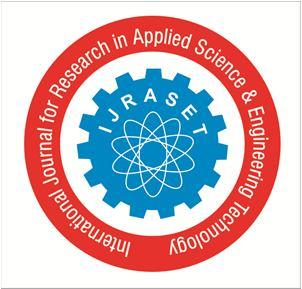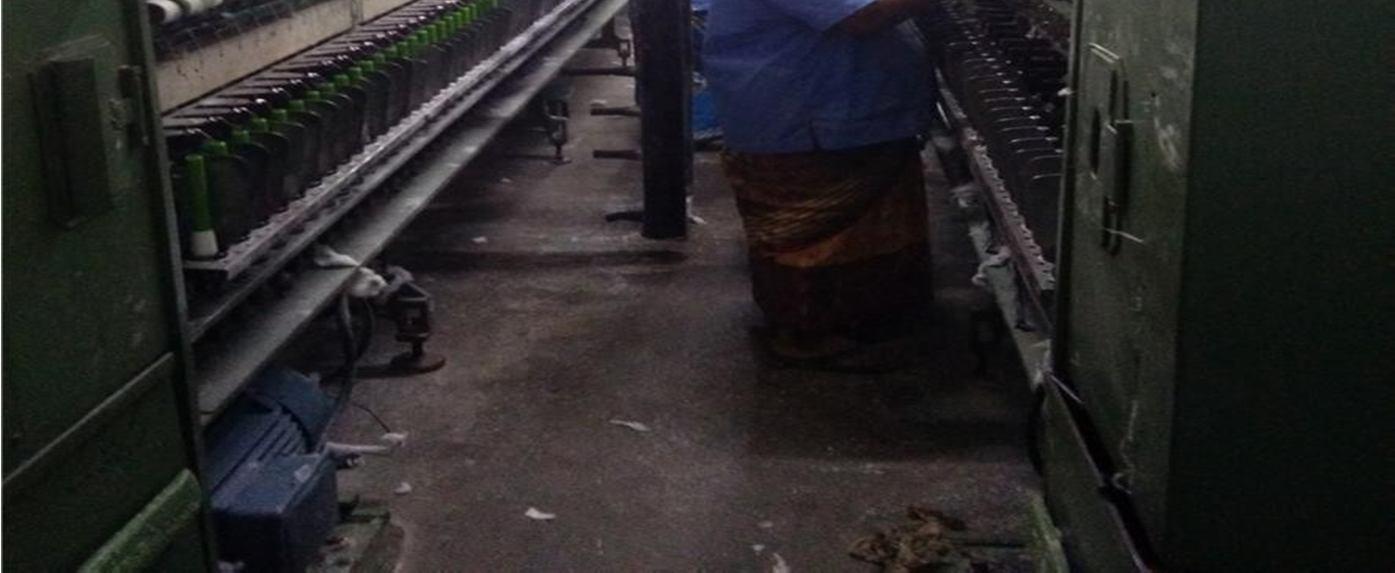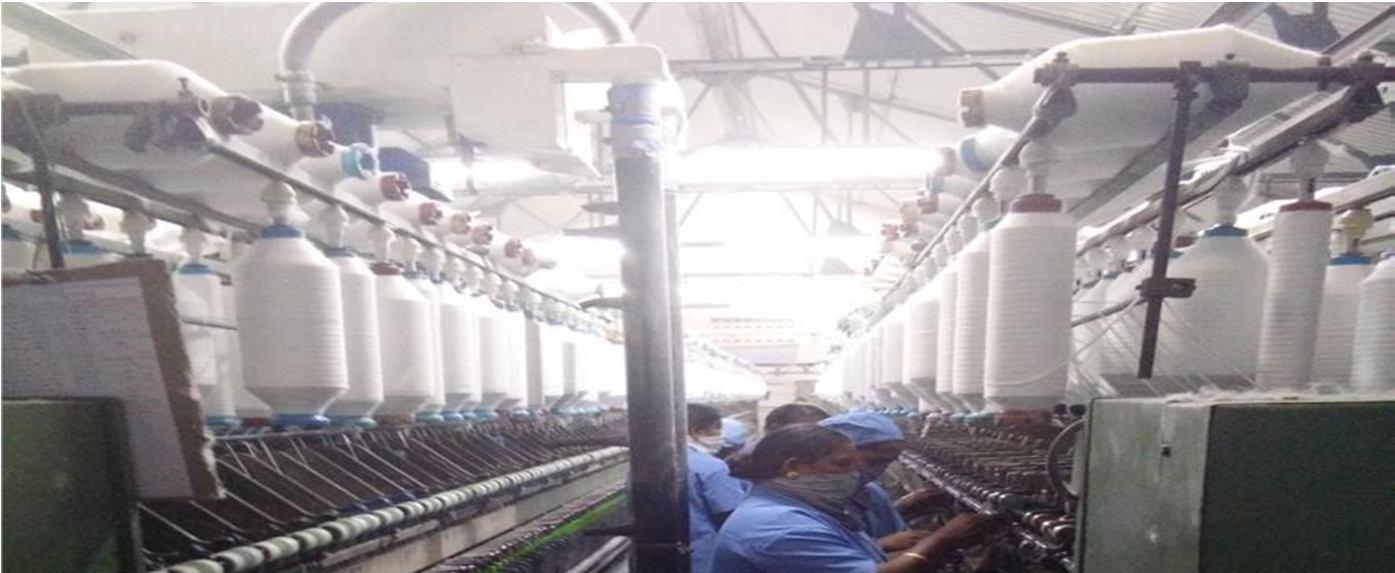

Occupational Safety and Health Issuesin Spinning Industry
1PG Scholar, 2, 3Assistant Professor,
Ranjith R1 , Kannan P2,Kandasamy R3,Selvaraj G4
Associate Professor, Department of Mechanical Engineering, Selvam College of Technology, Namakkal,Tamilnadu, India

Abstract: The study of Occupational Safety and Health issues in spinning industry examines to promote Health and safety to the workers in India. The Hazards and risk involved in the spinning industry is high compared with other industries and least importance is given to spinning industries. Most of accident does not come tothe legal formalities. The People are not aware of Health & safety is due to the workers are uneducated and management not given importance due to promote OHS in spinning industry becomes a barriers in implementing OHS. The major hazards happen are physical, chemical, ergonomically & physiologically Hazards along with these some of things which can create hazards are more working hours,improper ventilation, dust and noise.
Keywords: MMF Man Made Fiber, OHS Occupational Health and Safety, MWF Metal Working Fluid, RPM Revolutions per minute.
I. INTRODUCTION
Thousands of workers are employed in Spinning industries under different job categories including Ginning, Carding, combing, spinning, packing. The Spinning industry workers are exposed to a number of chemicals including dyes, solvents, optical brighteners, finishing agents and numerous types of natural and synthetic fiber dusts which affect their health. In this paper an attempt has been made to summarize the self reported health problems among a group of spinning industry workers. Their lower socioeconomic status, coupled with the lack of other viable livelihood options, puts them at a particular disadvantage while dealing with health related problems.

II. LITERATURE REVIEW
Frequency of hearing loss among textile industry workers of weaving unit in Karachi, Pakistan by Ashraf HD, Younus MA, Kumar P, Siddiqui MT, Ali SS,Siddiqui MI.2009.Noise level is more than acceptable limit of 85 dB (A) for 8 hours exposure stipulated. There is an immediate need to develop and implement noise regulations in Pakistan.
Cotton Dust level in Textile industries and its impact on Human by B.M.Sangeetha M.Rajeswari, S.Atharsha, K.Saranyaa Sri, S.Ramya April 2013. Knitting process produces the maximum dust level compared to other process, so we suggest that the preventive measures in the knitting session particularlyshould be more effective than other sections.
Occupational Hazards and Illnesses of Filipino Women Workers in Export Processing Zones by Jinky Leilanie Lu, 2008. Many of the small and large scale companies reportedly had health and safety committees, none of them functioned properly.
A Study of Occupational Health and Safety in the Garment Industry in Bangalore by Laura Ceresna Chaturvedi, Anand Kumar October 2015 Health and safety provisions available to workers at their workplace were very rudimentary. Occupational health and safety needs to be also addressed from the careperspective, i.e., through theESI.
Reduced lung cancer mortality and exposure to synthetic fluids and biocide in the auto manufacturing industry by Mehta AJ,Malloy EJ,Applebaum KM,Schwartz J,Christiani DC,Eisen EA 2010, The protectiveeffect of synthetic MWF(Metal Working Fluid) against lung cancer mortality persisted through the extended period of follow up, although attenuated, and was observed only among workers with co exposure to biocide and synthetic MWF.
Unsafe work environment in Garment industries, Tirupur, India by Padmini D.S. Venmathi.A September 2012, The medium and small sized garment industries in Tirupur were found to have poor illumination, improper ventilation, excessive noise, congested work area, unergonomic workstations. Theworkers were exposed to dust, chemicals mainly in the form of solvents, ergonomical problems,psychosocial problems, etc. Vibration and noise caused by lawn maintenance machines in association with risk to health by P. Tint,G. Tarmas,T. Koppel,K. Reinhold and S.Kalle 2012 due to Whole body vibration levels can often be reducedby using vibration isolation and by installing suspension systems between theoperator and the vibrating source.
Engineering Technology (IJRASET

ISSN: 2321 9653; IC Value: 45.98; SJ Impact Factor: 7.538 Volume 10 Issue IX Sep 2022 Available at www.ijraset.com
A Study Of Pulmonary Functin Tests In Cotton Mill Workers Of Guntur District by Prabhakara Rao.K,srinivasa Rao.CH, Sumangali.P 2013 Inhalation of cotton dust causes release of histamine from mast cells. Histamine acts on the smooth muscles resulting broncho constriction. Air way mucus glands secrete more amount of mucus in the presence of histamine
III. FACTORS FOR PRODUCTION IN SPINNING MILL
In every factory, production efficiency defends on some factors or parameters. As like as other factory, production of Spinning mill defends on some factors. The factors which influence the production of spinning millare mentioned below:
A. Raw Material
Raw material has an important impact on yarn quality and production. Let’s see how it affects on yarn production? There are many parameters through which we can easily assess the properties of cotton; first one is the fiber length which is the most important characteristic of cotton and is measured in terms of staple length, span length and effective length. If fibers have good staple length it results in the form of high production. I think while choosing cotton we have to keep in mind all these factors otherwise it results in the form of great loss.
B. Labour
Labour is critical to the sector’s current competitiveness and long term viability. Workers’ skill levels, productivity and motivation, the industry’s ability to attract and retain the right quantity and quality of workers, domestic labor laws and regulations and workers’ living conditions and costs in urban areas, are all critical in the context of acontinuously changing economic environment. In South Asia and other emerging economies, where low cost labor is essential for industry competitiveness, the Spinning industry has been subject to various allegations of labor abuse, including long hours, forced overtime and low wages. In light of these factors, there have been many state and non state initiatives to try to ensure sound labor and other practices in the sector whilst maintaining its international competitiveness.
C. Machinery
Machinery is the back bone of every industry. In the textile industry machine are working 24 hours so it is important that its efficiency would be excellent. Let’s look at the comparison between the old and new machine. InSpinning Mills we analyzed that, “why new machine are better than old machine?” In the simplex department they have erected 10 frames and in which one of them is the old one. If we compare the old machine with the new machine in production point of view then, it is clear that new machines are better than old ones.
D. Maintenance
Proper maintenance of machine is necessary otherwise it results in the form of many problems like sudden shut downs and big production loss. In ATM maintenance is done on daily basis to overcome the problems which they are facing every day. Usually in ATM one machine is opened 30 in every department for maintenance. Proper maintenance results in the form ofefficient working of machine and good outputs. For example by proper Maintenance and by proper preparation of roving it results in the form ofminimizing the end breakage rate.
Sl.No Natural Fiber
Man Made Fiber
1 The fibers which we get fromnature recalled natural fiber. The fibers which aredeveloped byman recalled manmade fiber.
2 Generallyfibers arehydrophilic.

Generallyfibers arehydrophobic
3 No. of molecule controlled bynature. No. of molecule controlled byman.
4 Length of the fiber is nature given.
Length of the fiber is controlled byman.
5 We get fibers’ as staple or filament. No question about short or longstaplefiber. It depends on man will.
6 Less strength and durability.
ISSN: 2321 9653; IC Value: 45.98; SJ Impact Factor: 7.538


Volume 10 Issue IX Sep 2022 Available at www.ijraset.com
Morestrength and durability.
7 No need to spinneret for spinningprocess. Spinneret is essential for filamentproduction.
8 The fabric made from natural fiber iscomfortable and good for health.
Manmade fiber is not comfortableand notgood for health.
9 Natural fiber is not favorable forfinishing. Manmade fibers arefavorable forfinishing.
10 Comparativelyless durable thansynthetic fiber. Manmade fibers aremore durable thannatural fiber.
11 Fineness varies from one fiber toanother fiber. Fineness depends on themanufacturers
12 Natural fiber has a great demand ashumans wear. Synthetic fiber is widelyused in everydaylifeexcept humans wear.
13 Natural fiber is called environmentfriendly. Manmade fibers are not environment friendly. Some fibers areharmful for theenvironment like: Polypropylene.
14 Natural fibers needs to scouring and Bleachingprocess before wetprocessing. Scouring and bleaching is done in very fewcases
15 It is not possible to change in fiberstructure. It is easyto change in fiber structure.
16 It is expensive. It is cheaper.
17 Bears crimp naturally. We have to give crimp manually.
18 It grows with its natural color. Colors areadded in the solution bath asrequired.
19 It is easyto dye the fiber. Coloration is not so easyas natural fiber.
20 Dust and impurities could be in naturalfiber. No dust or impurities contain in syntheticfiber.
ISSN: 2321 9653; IC Value:

10 Issue IX Sep
SJ Impact Factor:

at www.ijraset.com

1) Blow Room: Blow room is the initial stage in spinning process. The name blow room is given because of the "air flow" And all process is done in blow room because of air flow. Blow room is consisting of different machines to carry out the objectives of blow room. In blow room the tuft size of cotton becomes smaller and smaller. In a word we can say a section in which the supplied compressed bales are opened, cleaned & blending or mixing to form uniform lap of specific length is called Blow room section. During the opening, cleaning, blending or mixing different faults or defects occur in blow room. Now I will discuss about faults/defects, causes and way to remedies in blow room section.


2) Speed Frame: Simplex is an intermediate process in which fibers are converted into low twist lea called roving. The sliver which is taken from draw frame is thicker so it is not suitable for manufacturing of yarn. Its purpose is to prepare input package for next process. This package is to prepare on a smallcompact package called bobbins. Roving machine is complicated, liable to fault, causes defect adds to the production costs and deliver the product. In this winding operation that makes us roving frame complex. There are two main basic reasons for using roving frame.

IV. HAZARDS


PHYSICAL
TYPES OF HAZARDS


A. Noise




AND EXPLOSIVE DUSTS














2321 9653; IC Value:
at www.ijraset.com

7x8x7=392
of

8x9x8=576
Increase the no.of
Housekeeping
6x7x6=252
7x6x7=294
Keep
8x9x9=648
Technology (IJRASET
ISSN: 2321 9653; IC Value: 45.98; SJ Impact Factor: 7.538
Volume 10 Issue IX Sep 2022 Available at www.ijraset.com
V. CONCLUSION

The Project was done with an intention to study the hazardous effects over people working in the Spinning industry. The major hazards happen arephysical, Electrical, Chemical , ergonomically & physiologically Hazards, along with these some of things which can create hazards are more working hours, noise, dust and improper ventilation.The human body capacity and the proper design of the equipment are effective only if the environment is congenial. With aiming for continual improvement the project work will focusing give the solution for manmade fiber spinning industry workers to realize their health and safety at work place.
REFERENCES
[1] Ashraf HD, Younus MA, Kumar P, Siddiqui MT, Ali SS, Siddiqui MI. 2009 “Frequency of hearing loss among textile industry workers of weaving unit in Karachi, Pakistan”

[2] B.M.Sangeetha M.Rajeswari, S.Atharsha, K.Saranyaa Sri, S.Ramya, April2013. “Cotton Dust level in Textile industries and itsimpact on Human”.
[3] Jinky Leilanie Lu, 2008 “Occupational Hazards and Illnesses of Filipino Women Workers in Export Processing Zones”
[4] Mehta AJ, Malloy EJ, Applebaum KM, Schwartz J, Christiani DC, Eisen EA,2010. “Reduced lung cancer mortality and exposure to synthetic fluids and biocide in the auto manufacturing industry”.
[5] P. Tint, G. Tarmas, T. Koppel, K. Reinhold and S. Kalle ,2012. “Vibrationand noise caused by lawn maintenance machines in association with risk to health”.
[6] Padmini D.S. Venmathi A, September 2012. “Unsafe work environment in Garment industries, Tirupur, India”.
[7] Prabhakara Rao.K, srinivasa Rao.CH, Sumangali.P 2013. “A Study Of PulmonaryFunctin Tests In Cotton Mill WorkersOf Guntur District”.

